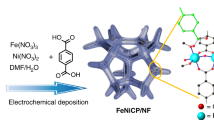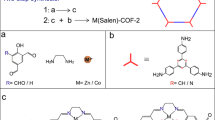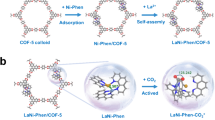Abstract
The design of highly electron-active and stable heterogeneous catalysts for the ambient nitrogen reduction reaction is challenging due to the inertness of the N2 molecule. Here, we report the synthesis of a zinc-based coordination polymer that features bridging dinitrogen anionic ligands, {[Zn(L)(N2)0.5(TCNQ–TCNQ)0.5]·(TCNQ)0.5}n (L is tetra(isoquinolin-6-yl)tetrathiafulvalene and TCNQ is tetracyanoquinodimethane), and show that it is an efficient photocatalyst for nitrogen fixation under an ambient atmosphere. It exhibits an ammonia conversion rate of 140 μmol g−1 h−1 and functions well also with unpurified air as the feeding gas. Experimental and theoretical studies show that the active [Zn2+–(N≡N)−–Zn2+] sites can promote the formation of NH3 and the detachment of the NH3 formed creates unsaturated [Zn2+···Zn+] intermediates, which in turn can be refilled by external N2 sequestration and fast intermolecular electron migration. The [Zn2+···Zn+] intermediates stabilized by the sandwiched cage-like donor–acceptor–donor framework can sustain continuous catalytic cycles. This work presents an example of a molecular active site embedded within a coordination polymer for nitrogen fixation under mild conditions.

This is a preview of subscription content, access via your institution
Access options
Access Nature and 54 other Nature Portfolio journals
Get Nature+, our best-value online-access subscription
$29.99 / 30 days
cancel any time
Subscribe to this journal
Receive 12 print issues and online access
$259.00 per year
only $21.58 per issue
Buy this article
- Purchase on Springer Link
- Instant access to full article PDF
Prices may be subject to local taxes which are calculated during checkout





Similar content being viewed by others
Data availability
All experimental details and data supporting the findings of this study are available within the paper and its Supplementary Information. The data are also available from the corresponding authors upon reasonable request. Crystallographic data for the NJUZ-1 structure have been deposited at the Cambridge Crystallographic Data Centre, under deposition number CCDC 2008863. Copies of the data can be obtained free of charge via https://www.ccdc.cam.ac.uk/structures/. Source data are provided with this paper.
References
Ertl, G. Reactions at surfaces: from atoms to complexity (Nobel Lecture). Angew. Chem. Int. Ed. 47, 3524–3535 (2008).
Foster, S. L. et al. Catalysts for nitrogen reduction to ammonia. Nat. Catal. 1, 490–500 (2018).
Jia, H.-P. & Quadrelli, E. A. Mechanistic aspects of dinitrogen cleavage and hydrogenation to produce ammonia in catalysis and organometallic chemistry: relevance of metal hydride bonds and dihydrogen. Chem. Soc. Rev. 43, 547–564 (2014).
Hinchliffe, A (ed.) Chemical Modelling: Applications and Theory Vol. 5 (RSC Publishing, 2009).
Rayment, T., Schlögl, R., Thomas, J. M. & Ertl, G. Structure of the ammonia synthesis catalyst. Nature 315, 311–313 (1985).
Zhou, F. et al. Electro-synthesis of ammonia from nitrogen at ambient temperature and pressure in ionic liquids. Energy Environ. Sci. 10, 2516–2520 (2017).
Ithisuphalap, K. et al. Photocatalysis and photoelectrocatalysis methods of nitrogen reduction for sustainable ammonia synthesis. Small Methods 3, 1800352 (2019).
MacKay, B. A. & Fryzuk, M. D. Dinitrogen coordination chemistry: on the biomimetic borderlands. Chem. Rev. 104, 385–402 (2004).
Hoffman, B. M., Lukoyanov, D., Yang, Z.-Y., Dean, D. R. & Seefeldt, L. C. Mechanism of nitrogen fixation by nitrogenase: the next stage. Chem. Rev. 114, 4041–4062 (2014).
Zhang, Y., Zuo, J.-L., Zhou, H.-C. & Holm, R. H. Rearrangement of symmetrical dicubane clusters into topological analogues of the P cluster of nitrogenase: nature’s choice? J. Am. Chem. Soc. 124, 14292–14293 (2002).
Yandulov, D. V. & Schrock, R. R. Catalytic reduction of dinitrogen to ammonia at a single molybdenum center. Science 301, 76–78 (2003).
Arashiba, K., Miyake, Y. & Nishibayashi, Y. A molybdenum complex bearing PNP-type pincer ligands leads to the catalytic reduction of dinitrogen into ammonia. Nat. Chem. 3, 120–125 (2011).
Anderson, J. S., Rittle, J. & Peters, J. C. Catalytic conversion of nitrogen to ammonia by an iron model complex. Nature 501, 84–87 (2013).
Chalkley, M. J., Drover, M. W. & Peters, J. C. Catalytic N2-to-NH3 (or -N2H4) conversion by well-defined molecular coordination complexes. Chem. Rev. 120, 5582–5636 (2020).
Roux, Y., Duboc, C. & Gennari, M. Molecular catalysts for N2 reduction: state of the art, mechanism, and challenges. Chem. Phys. Chem. 18, 2606–2617 (2017).
Yang, Q., Xu, Q. & Jiang, H.-L. Metal–organic frameworks meet metal nanoparticles: synergistic effect for enhanced catalysis. Chem. Soc. Rev. 46, 4774–4808 (2017).
Wang, H.-Y. et al. Functional coordination polymers based on redox-active tetrathiafulvalene and its derivatives. Coord. Chem. Rev. 345, 342–361 (2017).
Jiao, L., Wang, Y., Jiang, H.-L. & Xu, Q. Metal–organic frameworks as platforms for catalytic applications. Adv. Mater. 30, 1703663 (2018).
Mars, P. & van Krevelen, D. W. Oxidations carried out by means of vanadium oxide catalysts. Chem. Eng. Sci. 3, 41–59 (1954).
Blatov, V. A., Shevchenko, A. P. & Proserpio, D. M. Applied topological analysis of crystal structures with the program package ToposPro. Cryst. Growth Des. 14, 3576–3586 (2014).
Kim, J., Silakov, A., Yennawar, H. P. & Lear, B. J. Structural, electronic, and magnetic characterization of a dinuclear zinc complex containing TCNQ− and a μ–[TCNQ–TCNQ]2− ligand. Inorg. Chem. 54, 6072–6074 (2015).
Kuriyama, S., Arashiba, K., Yoshizawa, K. & Nishibayashi, Y. Catalytic formation of ammonia from molecular dinitrogen by use of dinitrogen-bridged dimolybdenum–dinitrogen complexes bearing PNP-pincer ligands: remarkable effect of substituent at PNP-pincer ligand. J. Am. Chem. Soc. 136, 9719–9731 (2014).
Coffinet, A., Simonneau, A. & Specklin, D. in Encyclopedia of Inorganic and Bioinorganic Chemistry (ed. Scott, R. A.) 1–25 (John Wiley & Sons, 2020).
Gallagher, N. M., Bauer, J. J., Pink, M., Rajca, S. & Rajca, A. High-spin organic diradical with robust stability. J. Am. Chem. Soc. 138, 9377–9380 (2016).
Wilson, A. Tables of interatomic distances and configuration in molecules and ions. Acta Cryst. 12, 174 (1959).
Li, M. et al. Recent progress on electrocatalyst and photocatalyst design for nitrogen reduction. Small Methods 3, 1800388 (2019).
Hirakawa, H., Hashimoto, M., Shiraishi, Y. & Hirai, T. Photocatalytic conversion of nitrogen to ammonia with water on surface oxygen vacancies of titanium dioxide. J. Am. Chem. Soc. 139, 10929–10936 (2017).
Ashida, Y., Arashiba, K., Nakajima, K. & Nishibayashi, Y. Molybdenum-catalysed ammonia production with samarium diiodide and alcohols or water. Nature 568, 536–540 (2019).
Cui, P. et al. A multicentre-bonded [ZnI]8 cluster with cubic aromaticity. Nat. Commun. 6, 6331 (2015).
Narayan, T. C., Miyakai, T., Seki, S. & Dincă, M. High charge mobility in a tetrathiafulvalene-based microporous metal–organic framework. J. Am. Chem. Soc. 134, 12932–12935 (2012).
Su, J. et al. High electrical conductivity in a 2D MOF with intrinsic superprotonic conduction and interfacial pseudo-capacitance. Matter 2, 711–722 (2020).
Alves, H., Molinari, A. S., Xie, H. & Morpurgo, A. F. Metallic conduction at organic charge-transfer interfaces. Nat. Mater. 7, 574–580 (2008).
Bhutto, S. M. & Holland, P. L. Dinitrogen activation and functionalization using β-diketiminate iron complexes. Eur. J. Inorg. Chem. 2019, 1861–1869 (2019).
Grimme, S., Antony, J., Ehrlich, S. & Krieg, H. A consistent and accurate ab initio parametrization of density functional dispersion correction (DFT-D) for the 94 elements H-Pu. J. Chem. Phys. 132, 154104 (2010).
Materials Studio v.7.0 (Accelrys, 2013).
Nørskov, J. K. et al. Origin of the overpotential for oxygen reduction at a fuel-cell cathode. J. Phys. Chem. B 108, 17886–17892 (2004).
Frisch, M. J. et al. Gaussian 16, revision A.03 (Gaussian Inc., 2016).
Tomasi, J., Mennucci, B. & Cammi, R. Quantum mechanical continuum solvation models. Chem. Rev. 105, 2999–3094 (2005).
Becke, A. D. Density-functional exchange-energy approximation with correct asymptotic behavior. Phys. Rev. A 38, 3098–3100 (1988).
Perdew, J. P. Density-functional approximation for the correlation energy of the inhomogeneous electron gas. Phys. Rev. B 33, 8822–8824 (1986).
Schäfer, A., Horn, H. & Ahlrichs, R. Fully optimized contracted Gaussian basis sets for atoms Li to Kr. J. Chem. Phys. 97, 2571–2577 (1992).
Zhao, Y. & Truhlar, D. G. A new local density functional for main-group thermochemistry, transition metal bonding, thermochemical kinetics, and noncovalent interactions. J. Chem. Phys. 125, 194101 (2006).
Weigend, F. & Ahlrichs, R. Balanced basis sets of split valence, triple zeta valence and quadruple zeta valence quality for H to Rn: Design and assessment of accuracy. Phys. Chem. Chem. Phys. 7, 3297–3305 (2005).
Delley, B. From molecules to solids with the DMol3 approach. J. Chem. Phys. 113, 7756–7764 (2000).
Segall, M. D. et al. First-principles simulation ideas, illustrations and the CASTEP code. J. Phys. Condens. Matter 14, 2717 (2002).
Roy, L. et al. Reduction of CO2 by a masked two-coordinate cobalt(I) complex and characterization of a proposed oxodicobalt(II) intermediate. Chem. Sci. 10, 918–929 (2019).
Légaré, M. A. et al. The reductive coupling of dinitrogen. Science 363, 1329–1332 (2019).
Li, S., Ma, J. & Jiang, Y. Linear scaling local correlation approach for solving the coupled cluster equations of large systems. J. Comput. Chem. 23, 237–244 (2002).
Ni, Z., Guo, Y., Neese, F., Li, W. & Li, S. Cluster-in-molecule local correlation method with an accurate distant pair correction for large systems. J. Chem. Theory Comput. 17, 756–766 (2021).
Ni, Z., Li, W. & Li, S. Fully optimized implementation of the cluster-in-molecule local correlation approach for electron correlation calculations of large systems. J. Comput. Chem. 40, 1130–1140 (2019).
Guo, Y., Becker, U. & Neese, F. Comparison and combination of “direct” and fragment based local correlation methods: Cluster in molecules and domain-based local pair natural orbital perturbation and coupled cluster theories. J. Chem. Phys. 148, 124117 (2018).
Li, W., Chen, C., Zhao, D. & Li, S. LSQC: Low scaling quantum chemistry program. Int. J. Quantum Chem. 115, 641–646 (2015).
Neese, F., Wennmohs, F., Becker, U. & Riplinger, C. The ORCA quantum chemistry program package. J. Chem. Phys. 152, 224108 (2020).
Acknowledgements
This work was supported by the National Key Research and Development Program (2018YFA0306004 and 2017YFA0208200), the National Natural Science Foundation of China (22022505, 22033004, 21875099, 21872069 and 21631006), the Fundamental Research Funds for the Central Universities of China (020514380266, 020514380272 and 020514380274), the Scientific and Technological Innovation Special Fund for Carbon Peak and Carbon Neutrality of Jiangsu Province (BK20220008), the Nanjing International Collaboration Research Program (202201007 and 2022SX00000955) and the Suzhou Gusu Leading Talent Program of Science and Technology Innovation and Entrepreneurship in Wujiang District (ZXL2021273).
Author information
Authors and Affiliations
Contributions
Y.X., B.L. J.-L.Z. and Z.J. conceived the idea of this study and designed the experiments. Y.X. and B.L. performed the sample synthesis, material characterizations, photoelectric measurements, photocatalytic tests and data analysis. Y.G., Z.N., S.L. and J.M. performed the theoretical calculations. All the authors analysed the data and discussed the results. Y.X., B.L., J.M. Z.J. and J.-L.Z. co-wrote and revised the manuscript. Z.J. and J.-L.Z. supervised the project.
Corresponding authors
Ethics declarations
Competing interests
The authors declare no competing interests.
Peer review
Peer review information
Nature Chemistry thanks the anonymous reviewers for their contribution to the peer review of this work.
Additional information
Publisher’s note Springer Nature remains neutral with regard to jurisdictional claims in published maps and institutional affiliations.
Extended data
Extended Data Fig. 1 Synthetic process and 1H-NMR analysis of L.
a Schematic synthetic process of L ligand. b 1H-NMR spectrum of CDCl3 dissolved L ligand.
Extended Data Fig. 2 Schematic structure diagram of NJUZ-1.
a (2, 4, 6) 3-nodal simplified 3D topological network of NJUZ-1. b The 2D layered structure of NJUZ-1 viewed along the b axis. c The interactions of π···π stacking and C-H···N hydrogen bonds in the cage of [(L)2(Zn2N2)4].
Extended Data Fig. 3 Spectroscopy and EPR characterizations of NJUZ-1.
a The IR spectra measured in air (black curve) and vacuum (dark cyan curve). The two split peaks at around 2100 cm−1 are attributed to the cyano groups in TCNQ. b Simulated IR spectrum of C≡N bonds in NJUZ-1 calculated by DFT at level1. c Raman spectra of 14N-NJUZ-1 and 15N-NJUZ-1. The peak at ~2005 cm−1 is dinitrogen complexes for 14N-NJUZ-1. As for 15N-NJUZ-1, the 15N≡15N stretching vibration is at ~1920 cm−1, with a small red shift (~80 cm−1) compared to that of 14N-NJUZ-1. The peaks at 2224, 2203 and 2192 cm−1 are derived from the cyano groups in TCNQ. d Simulated Raman spectrum of Zn-C≡N-Zn structure calculated by DFT at level1. The insert shows the proposed Zn-C≡N-Zn structure. e Experimental solid EPR spectrum at low temperature (93 K) compared with simulated EPR spectrum (ν = 9.4452 GHz). f Experimental solid EPR spectrum of 15N-NJUZ-1 measured at room temperature (ν = 9.8519 GHz). a.u. refers to absorbance unit.
Extended Data Fig. 4 Spin-density distributions of cluster models and PBC models.
a cluster models and b PBC models. The values of spin-populations (isovalue = 0.005) on N2 ligands are given in square brackets.
Extended Data Fig. 5 Spin-density distributions of different reaction intermediates at reaction sites (ClusterA models).
The values of spin-populations (isovalue = 0.005) on N2 ligands are given in square brackets.
Extended Data Fig. 6 Structure characterizations of NJUZ-1.
a Representative TEM image of NJUZ-1. b Typical AFM image and the corresponding height profiles of NJUZ-1. c N2 adsorption isotherm of NJUZ-1 at room temperature.
Extended Data Fig. 7 TDDFT calculations of excitation energies.
a UV-Vis spectrum and fingertip aspects of NJUZ-1. b ClusterA and ClusterB models, which were built from NJUZ-1 crystal. c The TDDFT calculated orbital energy levels of ClusterA. d The TDDFT calculated orbital energy levels of ClusterB. a.u. refers to arbitrary unit.
Extended Data Fig. 8 NRR performances and structure characterizations of NJUZ-1.
a The percentage of ammonia yield rate of NJUZ-1 with unpurified air flow compared to that with N2 flow. b Total ammonia yield of NJUZ-1 after a long-term NRR process for 25 h. c Typical gas chromatograph spectrum (measured by TCD detector) of the gas byproducts yielded during the NRR process catalyzed by NJUZ-1. d XRD patterns of NJUZ-1 before and after 3, 10 and 25 h of the NRR in comparison with the simulated XRD pattern, respectively. e and f Typical TEM image of NJUZ-1 after the NRR for 3 and 10 h, respectively. g Nitrogen adsorption-desorption isotherms of representative NJUZ-1 before and after the NRR test for 25 h. a.u. refers to arbitrary unit.
Extended Data Fig. 9 Isotope labelling experiments and spin-density distributions with water in ClusterA.
a 1H NMR spectrum of the products measured from 15N-NJUZ-1 after the NRR process for 20 h under Ar atmosphere. b 2H and 1H-NMR analyses of ND3 product after the NRR process of NJUZ-1 in D2O. c Spin-density distributions in ClusterA models with H2O adsorption. The values of spin-populations (isovalue = 0.005) on N2 ligands are given in square brackets. d Solid-state NMR analyses of standard 15NH4Cl sample (black curve) and the NJUZ-1 photocatalyst after the NRR process with 15N2 feeding gas for 20 h (dark cyan curve).
Extended Data Fig. 10 Schematic crystal structure and proposed NRR reaction pathways over NJUZ-1.
a Schematic crystal structure of NJUZ-1. The purple, grey, blue, yellow, and white balls are corresponding to Zn, C, N, S, and H atoms, respectively. b Gibbs free energy profile of the NRR process over NJUZ-1 with alternating (blue), mixed (green) and distal (grey) pathways. c Proposed reaction pathways for the NRR process over NJUZ-1. d Charge variation of the N2-mHn species along the possible alternating, mixed and distal pathways, respectively.
Supplementary information
Supplementary Information
Supplementary Figs. 1–7 and Supplementary Tables 1–10.
Supplementary Data
Crystallographic data for NJUZ-1, CCDC 2008863.
Source data
Source Data Fig. 2a
Simulated Raman spectra data of Zn–N2–Zn structure.
Source Data Fig. 2b
Raman spectra data of 14N-NJUZ-1 and 15N-NJUZ-1.
Source Data Fig. 2c
EPR spectrum data of NJUZ-1.
Source Data Fig. 3c
Ammonia yield data with N2, unpurified air, Ar or O2 flow.
Source Data Fig. 3d
Ammonia yield data for 10 h with N2 flow.
Source Data Fig. 4b
Raman spectra data of NJUZ-1 measured at pristine state (saturated) and during the NRR process (unsaturated).
Source Data Extended Data Fig. 3a
IR spectra data of NJUZ-1 in air (black curve) and vacuum (dark cyan curve).
Source Data Extended Data Fig. 3b
Simulated IR spectrum data of C≡N bonds in NJUZ-1.
Source Data Extended Data Fig. 3c
Full Raman spectra data of 14N-NJUZ-1 and 15N-NJUZ-1.
Source Data Extended Data Fig. 3d
Simulated Raman spectrum data of Zn–C≡N–Zn structure.
Source Data Extended Data Fig. 3e
Experimental and simulated EPR spectrum data at low temperature (93 K) of NJUZ-1.
Source Data Extended Data Fig. 3f
EPR spectrum data of 15N-NJUZ-1.
Source Data Extended Data Fig. 6c
N2 adsorption isotherms data of NJUZ-1.
Source Data Extended Data Fig. 8a
Percentage of ammonia yield data with Air to N2 flow.
Source Data Extended Data Fig. 8b
25 h long-term ammonia yield data with N2 flow.
Source Data Extended Data Fig. 8d
XRD data of NJUZ-1 before and after 3, 10 and 25 h of the NRR in comparison with the simulated XRD pattern.
Source Data Extended Data Fig. 8g
Nitrogen adsorption–desorption isotherms data of NJUZ-1 before and after 25 test.
Source Data Extended Data Fig. 10d
Charge variation data of the N2-mHn species along the possible alternating, mixed and distal pathways.
Source Data Supplementary Fig. 2
TGA data of NJUZ-1.
Source Data Supplementary Fig. 6
Standard calibration data of NH4+.
Rights and permissions
Springer Nature or its licensor (e.g. a society or other partner) holds exclusive rights to this article under a publishing agreement with the author(s) or other rightsholder(s); author self-archiving of the accepted manuscript version of this article is solely governed by the terms of such publishing agreement and applicable law.
About this article
Cite this article
Xiong, Y., Li, B., Gu, Y. et al. Photocatalytic nitrogen fixation under an ambient atmosphere using a porous coordination polymer with bridging dinitrogen anions. Nat. Chem. 15, 286–293 (2023). https://doi.org/10.1038/s41557-022-01088-8
Received:
Accepted:
Published:
Issue Date:
DOI: https://doi.org/10.1038/s41557-022-01088-8
This article is cited by
-
Progress and challenges in energy storage and utilization via ammonia
Surface Science and Technology (2023)



